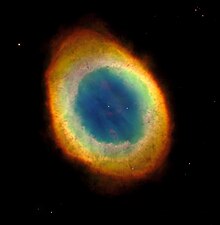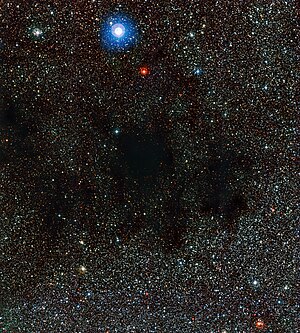Some nebulae are essentially cold hydrogen clouds. An H I region is a neutral atomic hydrogen cloud and an H II region is a cloud of ionised atomic hydrogen (or a bunch of floating protons. Fun, huh?).
You can also get molecular clouds, which are exactly as they sound--clouds of molecular hydrogen, which are ideal for star formation. (Apply your Jeans mass and Jeans length here.)
There's planetary nebulae, which have nothing to do with planets (blame Herschel). These brightly-glowing nebulae result from an old low-mass red giant star puffing off it's outer layers as it dies. Planetary nebulae are a good way for a star to release the products of its fusion--namely, all the elements they synthesized up to iron.
They glow not because they're still undergoing fusion, but re-emitting the light from stars--including its central star. This is why so many of them look like pretty eyes.
Ring Nebula:
Lemon Slice Nebula:
Eye of God Nebula:
This one looks like Sauron:
Supernova remnants occur when large stars (more than 8 solar masses) end their lives by going boom, er rather, when they go B O O M!! Becuase of this, they tend to look a bit more scatter-shot than planetary nebulae.
the famous Crab Nebula:
Puppis A:
Now, we know these nebulae are supernova remnants because for a few of them, humans actually witnessed and recorded the supernova that created them. The Crab Nebula went boom in 1054AD and Tycho's Supernova happened in 1572.
Most nebula are visible because they re-emit or reflect light, but some nebula, like dark nebula, are absorption nebulae with enough dust and density to block out any light. Unlike the light hydrogen clouds, these tend to be metallic or 'dirty', with lots of elements and molecules in them.
We know about them because they often block out light and appear as a dark splotch against a brighter background.
Coalsack Nebula, located in the Southern Cross constellation:
While they might not be as visually interesting as their emittive or reflective cousins, don't give them any side-eye, though. These nebulae are as important as their sisters for star formation.
Speaking of star formation, here's a Hubble picture of the Orion Nebula with several young stars:
In conclusion, nebulae are clouds, often left over from the death of stars, that are capable of birthing new stars.
Hardcore: Nebulae. Have fun and knock yourself out.
________________________________
Her Grace is glad she doesn't have to die and go boom in order to give birth to promising young stars.








.jpg/500px-Orion_Nebula_with_proplyd_highlights_(captured_by_the_Hubble_Space_Telescope).jpg)
9 comments:
Those are some amazingly beautiful pictures. I learned something new today from your post and was inspired by the natural beauty of each nebula.
Ann, A to Z Challenge Participant
Harvest Moon by Hand – a blog about homeschooling, crafting, cooking, and nature
Nature, New Year’s Eve, and Nutrition
I didn't know there were so many kinds of nebulae. The pictures are gorgeous!
These are just unbelievably gorgeous. And to think, they have the potential to give birth to new stars... wow. Just wow.
Ooh, how beautiful! And yes, that one does look like the Eye of Sauron!
Beautiful! And informative, too. Space is fascinating.The Ninja Librarian’s Favorite Characters
Informative and resourceful. Thanks for sharing the detailed information.
------------------------------------------------
Anagha From Team MocktailMommies
Collage Of Life
This post is very interesting, you provided the information in a manner that could be easily understood.
Nature is stunning! beyond measure. Here from the A-Z and thoroughly enjoyed reading.
All the best,
Nilanjana
Madly-in-Verse
What an interesting and informative post! I find space super interesting but really daunting at the same time.
Today on my A-Z of my Favourite Things, N is for the Ninja Book Swap.
Post a Comment